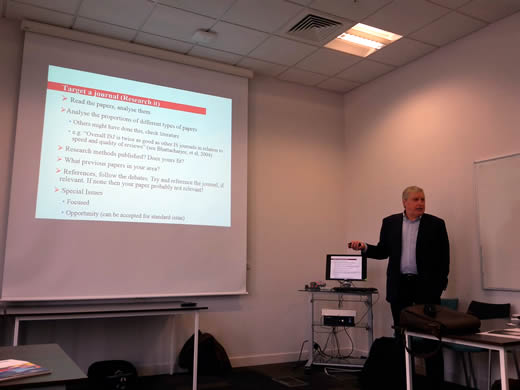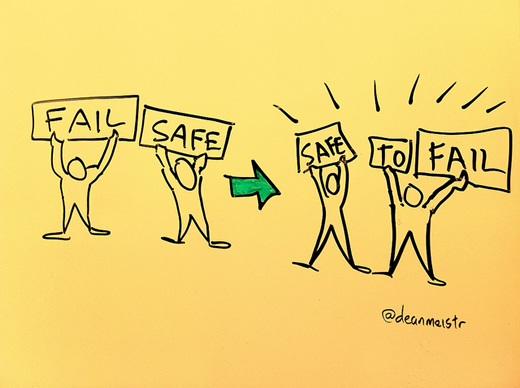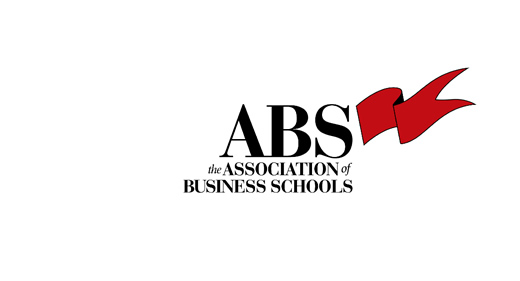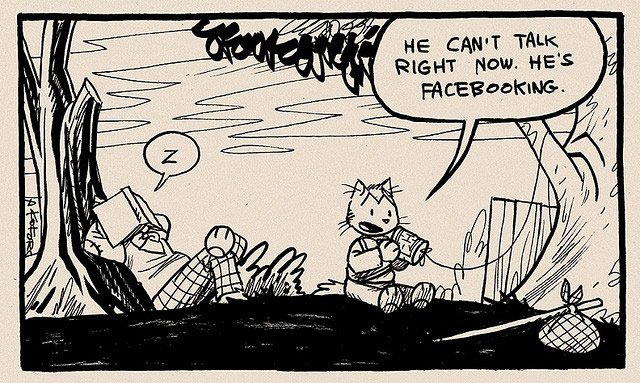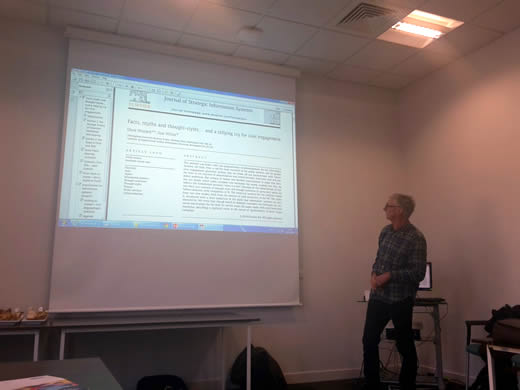
What should business school academics and those aspiring for a career in a business and management field focus on? The classic four P’s:
- Publications (high quality journal articles),
- Pounds (research income),
- PhD students (the graduation of successful PhD students) and
- Presence (engagement in conventional press, keynotes etc.) are constantly being extended.
In REF 2014 for example, the change was the introduction of Impact – namely, evidence that research has made a difference in the real world and in REF 2020 it is the importance of open access.
18th December 2014 is the date when the results of REF 2014 are published. However, the work has already been done and individuals who were involved in the evaluation process have reported to their units of assessment – the one most relevant to UK Business Schools is Unit 19 – Business and Management Studies.
So, what are the lessons for UK based academics post REF 2014?
Research development workshop
The British Academy of Management (BAM) and the UK Academy of Information Systems (UKAIS) held a research development workshop at Newcastle University Business School on the 20th and 21st of November 2014. The implications of the REF process upon academic writing were discussed at length. These discussions were led by Professor Guy Fitzgerald – sub-panel 19 member, Professor David Wainwright – sub-panel 19 assessor, Professor Cathy Urquhart who headed research at the Manchester Metropolitan University in the lead up to REF2014 and Professor David Wastell – president of the UKAIS.
The main themes that were identified are based on workshop discussions facilitated by the BAM E-business and E-government Special Interest Group in collaboration with the UKAIS. As a result of this focus there is an Information Systems perspective in these thoughts, but the main points are helpful for all business school academics as well as those in other disciplines.
The workshop also provided a platform for doctoral students and early career researchers to present their work, receive constructive feedback from experienced academics, and to network with fellow research colleagues. Keynote speeches provided up-to-date perspectives on research, focussing on all stages of the research process including theory development, relevant methodologies and a number of career-related topics.
Prof Guy Fitzgerald, Loughborough University
Keynote speakers
- Prof Guy Fitzgerald, Loughborough University
- Prof Cathy Urquhart, Manchester Metropolitan University
- Prof David Wastell, Nottingham University Business School
Facilitators
- Dr Aleksej Heinze, Salford Business School
- Dr Rachel McLean, Liverpool Business School
- Prof Savvas Papagiannidis, Newcastle University Business School
- Prof David Wainwright, Newcastle Business School
So, here are the top ten themes that emerged from this workshop:
1) Academic writing and publishing in top academic journals
Image (CC) by Xlibber
There were nearly 13,000 outputs submitted to the Business and Management sub-panel (unit 19) for REF 2014. This sub-panel did not use journal rankings, such as the ABS list, to make their assessments. The ABS list is the International Guide to Academic Journal Quality (The Guide) and is due to be updated in February 2015.
The ABS list is useful. It is heavily used by deans of business schools to evaluate staff when making recruitment and promotion decisions. However, it should be remembered that the REF did not use the ABS or any other lists when making its evaluations. Not all papers in 4* ABS listed journals were rated 4* or vice versa. But equally there are some correlations to be found between journals and the ranking that individual papers received.
Clearly, publishing in top ranked journals is one of the ways to sustain a career in the academic world. However, it is recognised that the downside of this system is that it is difficult to get published in these top journals and it can take a long time to be accepted. The suggestion from the workshop was to focus and work on fewer high quality publications rather than having several low quality outputs – “Less is MORE”.
2) Rejection and feedback can help to plan your academic writing
Image (CC) by Frits Ahlefeldt-Laurvig
It was recognised that the feedback received from journal reviewers can often be demoralising. However, it is important to use the feedback to develop your paper and refine its content in order to get it published. It is very tempting to forget about a paper especially if a “Reject” is received. But this could be due to your misunderstanding of the journal scope and style or other criteria.
The developmental reviewing process means that the editors and reviewers can force you down a route that you might not want to take. The ultimate consequence could be that it is no longer your paper but that edited by the journal reviewers – this is sometimes the price for publication in a top journal.
The reviewers are there to say what is wrong with your paper. So, if you get bad reviews – treat these as a starting point! Even the most terrible reviews usually have something sensible to say about the paper. If a reviewer is not able to understand your point – you should re-write your paper to make it clearer.
You should reply to the editor and say whether you are planning to re-submit or not. Treat journal editors with respect – they are people – your fellow academic community members are running these journals. Beware that even if you send a paper to a different journal you might still get the same reviewer, so it is worth taking the feedback on-board before re-submitting it elsewhere.
When responding to your review, a table is a good way to structure and keep track of all the edits. Make sure that you address all the comments and record your responses as well as the changes you have made. This should make it easy for the reviewer to see what has been changed – help them. Suggested table column headings are:
Comment / Reply / Edited text and page number in the paper
3) Achieving impact does not mean academic writing in top journals
image (CC) by Andrea
Despite the advice in point 1, if your paper is rejected from a higher ranked journal, remember that lower ranked journals tend to take more risks and the readership of these journals could be high. For example, the Communications of the ACM can result in thousands of practitioner reactions, who are esteemed in their subject area even though the journal may not be highly ranked.
Some niche areas have very good communities and the consequence of this can be a very high readership especially when it comes to generating impact. Impact is likely to become increasingly important in the next REF.
4) Academic writing for new and up and coming journals
Go from “failsafe” to “It’s safe to fail!” (CC) by Dean Meyers
It can be difficult to get published in established journals that have higher esteem. The situation is different for new journals. As a tactic, keep an eye on new journals which might be easier and quicker to get published in. They might become more highly ranked in the future! New and upcoming journals could be good tactical speculation.
An example of such a journal is the Journal of the Association for Information Systems (JAIS). It was relatively easy to get into at the beginning but it is now highly ranked. The Evidence Based Information Systems Journal (EBISJ) is a UKAIS backed journal and has just come out. It could be a good opportunity for the right type of paper.
Special issues of journals are also a good way to get your papers published. Guest editors will give you a very specific and focused steer. Special issues of journals help you to focus your publications. It is worth monitoring the journals that you read regularly and have a regular interest.
5) Choose your subject area carefully
Image (CC) by Lauren Macdonald
Some of the subjects are not well served by the ABS list through their named specified categories. The IS community is one of these. There are only 2 journals ranked 4* and the rest are 3* or below under the Information Systems category. The majority of authors in these 4* journals are US based with few UK based individuals publishing in these top journals.
The other observation made about the top IS journals is that MISQ and ISR have a particular view of the world and these journals publish relatively standard papers and are perhaps less open to innovation.
On the positive side, there are many other ABS ranked journals where IS subject authors can submit their work – for example Technovation (3* – innovation subject area), Futures (2*), Technology Forecasting and Social Change (3*) or Long Range Planning (3* – strategy subject area). Satisfying the demand for relevant output while working in a business school can be easily achieved with a creative and more thorough reading of the entire ABS list.
6) REF 2014 Business and Management do not use ABS journal ranking
Whilst there is consensus that top academic journals (as identified by ABS) are still desirable for targeting your publications and help your career progression in a business school, these do not guarantee that the publication is of high quality. Conference papers and books are some of the other outputs that can and are considered by the REF – not just journal papers. However, over 90% of outputs submitted to the panel were journal papers. This is because journals are what research managers think is going to be evaluated. But this is not the case.
The Business and Management sub-panel in REF 2014 and the previous Research Assessment Exercises (RAEs) did not use the ABS list for their outputs assessment. Each output was read and assessed by the sub-panel. The 2008 RAE sub-panel report stated that world leading work was found in different places and the place of publication was not used as an evaluative criterion.
In the future REF2020 is likely to focus more on impact.
7) What is the secret of academic writing and publishing?
Secret (CC) image by val.pearl
The top journals only publish 5-10% of submissions. A lot of papers are screened out before the paper is sent for review because the paper might be too long, out of scope, or does not meet the other criteria as specified in the instructions for authors.
The secret is – do good research and write it up well. Editors are looking for rigour with the application of the methods applied and that makes an original contribution to knowledge.
Try and reference the journal that you are submitting to – but only if it is relevant. If you can’t find a relevant reference in your target journal – chances are you are targeting the wrong journal. Tailor your paper to the journal. Look at the structure of papers in the journal, look at the discussions, look at the editors and the board – are they relevant to your work?
Editors often write in their editorials what they are looking for in terms of papers. This gives a clue of what to expect. Analyse the existing papers and the range of topics.
8) Writing about the right topic at the right time
Image (CC) by Ape Lad
Relevance is important too. Understanding the journal audience is important. Is your paper of interest to the journal? For example, around the London Olympics it seemed that papers related to this topical event were readily and rapidly published. What are the other wider topics that are of this current moment?
New areas tend to be published more readily. If a concept or topic is new journal readers want to know about it and are more likely to be interested in your work. Some current ‘hot’ topics of interest in Information Systems can be found in areas such as “crowdsourcing” and “crowdfunding”.
Some of the top journals have opinion piece sections but this approach might require some caution as outputs outside traditional papers may be evaluated by the REF as not containing research and therefore not highly rated.
9) Breaching experiment for your ideas
Prof David Wastell, Nottingham University Business School
Innovation is an important aspect of research and there is always space for making new ways of research. As Prof David Wastell puts it:
“A journal paper is not the END of your research!”
Getting your thoughts published in a journal is not the end of a process. What will this paper do now that it is published? How will this work be used by others? Impact will increase its importance in REF 2020. Getting people to read your work and apply it in practice or future research is what is going to create wider social difference.
Ultimately, you don’t want to get a paper published for the sake of it – think about your readers and what you would like them to do having read your paper. A published paper could be treated as a starting point for your work – how your work makes a difference could be your starting point of planning a paper.
Blue Sky Research is still important, but we need to think about the IMPACT and engagement with societal challenges. Understanding the real challenges of organisations and society means that collaborations with other areas would also be very important. Multi-disciplinary research is one of the ways that real world problems can be approached from an academic perspective.
“Reality does not exist until there is a material interaction”
“Write something that matters and publish it in the right place.”
Existing organisations such as the Federation of Small Businesses (FSB) publish their challenges and show how work in these areas could be important to improve their practice.
Use a theory other than Technology Acceptance Model (TAM)
Social Media is currently a major area in IS and other fields but there are a number of concerns. The Technology Acceptance Model (TAM) appears to remain one of the main contributions from our research. It would be great to have better contributions that do not involve TAM.
Qualitative research is a key to theory building. We learn so much by being grounded in practice. Why do we, as authors, think that TAM remains relevant to all the emerging areas of information systems research?
For example, engagement with social media: there is a lot of information about younger audiences in North America. We should avoid shoehorning a theory to fit an approach – better to consider a problem and then identify an appropriate theory to frame your discussions.
Study visuals
We are academics in 2014 but we are not studying visuals! There are some exceptions – art history, cultural studies do this, but in IS we don’t tend to do this. We should be looking for images, video and audio content.
The other interesting thing about social media is that someone can follow the trail of evidence and links. This is a great opportunity but also a challenge – where do you end your investigation? Where do you draw a boundary? Where do you stop?
Data is the new oil
Think about multi-methods – big data is here – it is now possible to predict certain things. Search Engine Optimisation is a perfect example of that – past search behaviour indicates what people are likely to search for and when.
However, just because you have a lot of data this is not always a reason to get meaning out of it. For example, search engines can also shape the way we see the world around us – we have to be careful with huge volumes of data. Increasingly search engines are personalised, therefore location-based search results alter what you see and how you interact with information.
10) Is your story well written?
Image (CC) by Nick Piggott
Logical story
This is a very important part of a paper – how it is written and if it is logical and well argued. The papers submitted in the REF 2014 were the ones that were “beautifully written”. Make sure that the readers don’t have to search for the story that is being told.
The paper needs to be convincing – get it checked and get others to comment. It could be your colleagues, your spouse, friends – they don’t need to be experts in your area – if they can’t understand the story chances are your paper is not clear. As an academic you have to be doing the sales job to get your paper accepted!
Make the research problem clear at the outset
The paper has to draw you in – make it clear why a certain person has to read it. You need to remember what the gap in the literature was that you were trying to close when you set out to write your paper.
Have an original contribution to knowledge
There should be some outcomes – preferably new not showing confirmation of existing work. This need for originality is counter productive for confirmatory research and reproducibility, but this is a trend amongst top journals and REF assessment panels.
Eisenhardt, K. M., & Graebner, M. E. (2007). Theory building from cases: opportunities and challenges. Academy of management journal, 50(1), 25-32.
Eisenhardt and Graebner 2007 is the key paper to examine for use of a theory and the steps for applying it. How can you make sure that your case studies are representative? You are generalising to a theory not a population – you are building analytic generalisations from your case study – it is there for building analytic generalisations.
How we select the case studies – when you are sampling cases you can and should sample case studies according to the developing theory. You decide on analytical grounds where to sample next. The process is know as the theoretical sampling. Glaser and Strauss 1967 talked about it but it is often missed from discussions and debates.
Glaser, B., & Strauss, A. (1967). The discovery of grounded theory. 1967. Weidenfield & Nicolson, London.
Implications and future work
There should be a discussion of the implication and what this means to the wider world as well as the specific area. Always have a number of contributions. Contributions to theory seems to be encouraged in the top journals.
Levina and Vaast MISQ paper uses Grounded Theory and integrates it at the highest level. It is a good example of a paper that links data to theory very well:
Levina, N., & Vaast, E. (2008). Innovating or doing as told? Status differences and overlapping boundaries in offshore collaboration. MIS quarterly, 307-332.
Think about theory building and concepts which are reflected back into the field. None of us are proper scholars if we have not integrated the theory to literature and integrated it back.
Some people can write and some people can’t
Work hard on this aspect – do not submit the paper to the journal before seeking other views. It is good to try it out at conferences and workshops – get some feedback and change the paper a bit from the conference. A rule of thumb is that you have to change about 20% to 30%.
Some journals have author workshops at conferences – these are worthy opportunities. You should take advantage of this. For example, out of the 10 people who attended the ICIS 2013 writing workshop, six managed to get their papers published.
Work in writing partnerships
It is always good to have a complementary writing partner. In paper writing you usually need skills that one person does not have. Find individuals who share your subject area and work with them. If you are working with somebody on a paper you get benefits from synergies and it almost always works in favour of all those involved. It is important to agree who is an author on the paper and who is not and in what order.
If you are starting out as a researcher, it is good to pair up with someone who has more publishing experience. The mentor could be in the same institution or in another – there are benefits to all who take part in such partnerships.
A good title and abstract are crucial
Title and abstract are the keys that will get you over the threshold. Yet, these are often the last things written and are often rushed and therefore poor.
The discussions/implications/conclusions/contributions should be well refined and convincing. This is the part of the paper where the story should be clear. The first things that the editors read are the title, abstract and conclusions as well as the list of references.
Get other people involved in the process of drafting.
Would you like to take part in similar workshops?
This content comes from a joint BAM/UKAIS workshop that was jointly organised by Professor Savvas Papagiannidis (Newcastle University) and Professor David Wainwright (Northumbria University), hosted and sponsored by Newcastle University Business School. The Society for the Advancement of Management Studies has also kindly made a number of travel bursaries available to Doctoral Students and Early Career Researchers.
This workshop is part of a series of 5 workshops in Ebusiness and Egovernment. If you are interested in participating as a facilitator or presenter please email the BAM Series Organiser, Prof Savvas Papagiannidis (savvas.papagiannidis@ncl.ac.uk)
The UKAIS conference is also offering a great research development opportunity especially for new researchers in business schools who use information technology as an area of their research. The call for UKAIS 2015 conference “Information Systems Impact: Making Research Matter” is now open – http://ukais.org.uk
Do you have some thoughts about the above points? Please do share them below.
